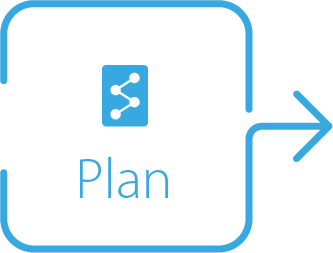Cloud Computing
Cloud Computing services cover a vast range of options, from the basics of storage, networking, and processing power through applications like ERP, CRM, and e-commerce into a more advanced services like NLP, AI, IoT, and Edge Computing; pretty much any service that doesn’t require you to be physically close to the computer hardware that you are using can now be delivered via the cloud.
![]()
![]()
![]()
![]()
1 - Consultancy
Whether it’s a large-scale physical to virtual cloud migration or a non-standard project that could use some outside know-how, there’s always a new test for the technology and business to overcome, which is where our consultants can help.
Strategy
Develop an actionable cloud strategy and roadmap that attains the right balance between agility, efficiency, innovation, and security to support the business cloud adoption journey.
Security
Extra security technology will not keep data, activities, and business safe; 90% of breaches are caused by human factors.
Our advisors will recommend the right security policy in the most appropriate way to the business while ensuring it isn’t slowing the technology down
Enablement
Instead of learn-by-doing, our cloud experts provide enablement consultancy services to ensures that the transformation process into the cloud is painless, simple, and speedy.
Migration
Cloud migration is more complicated than just a quick lift-and-shift. Our experts will show the way for a successful cloud migration that suites the business operations without disruption.
Cybersecurity
Cybersecurity is a critical concern for any organization. As cyber attacks become more common and sophisticated, a variety of cybersecurity solutions are required to mitigate corporate cyber risk.
2 - Cloud Transformation
It is the process of moving business’s data and applications (Workloads) from a legacy, on-premise IT infrastructure to a cloud computing environment (public, private, or hybrid).
Whether it is IaaS, PaaS, or SaaS, Cloud services delivery can be simple and more flexible than traditional methods, but that doesn’t mean migrating – or knowing what and when to migrate – to the cloud is without its challenges.
Migration Framework Pillars
 Security
Security Reliability
Reliability Performance Efficiency
Performance Efficiency Cost Optimization
Cost Optimization Operational Excellence
Operational Excellence
The Cloud migration journey starts with identifying components that will be migrated and the assessment of respective impacts.
This is required when planning a migration from an on-premises environment, a private hosting environment, another cloud provider, or if evaluating the opportunity to migrate.
The assessment phase is crucial for the success of the migration process; thus, understanding the starting point is the first step to successfully plan and execute a Cloud migration. Then, we need to gain deep knowledge about the apps to be migrated, their requirements, their dependencies, and about the current environment.
 Explore needs
Explore needs Apps assessment
Apps assessment Optimization and Map requirements to services
Optimization and Map requirements to services Select the right CSP
Select the right CSP Right-size service choice
Right-size service choice
(Compute, Storage and Data Transfer) Evaluation and ROI
Evaluation and ROI PoC
PoC
The correct design is fundamental to the successful implementation of Cloud services.
Having clear comprehension of which environments must be revised plays a key role in raising the effectiveness of IT and the return achieved on the implementation of Cloud services.
In the execution phase, we start the Cloud transformation roadmap, putting into action automation methodologies and tools to effectively accelerate and govern the migration process.
 Infrastructure architecture
Infrastructure architecture Roadmap
Roadmap Migration Plan
Migration Plan Existing application migration (rehost, refactor, and / or redevelop)
Existing application migration (rehost, refactor, and / or redevelop) New custom application development
New custom application development Data transfer
Data transfer Initial workload transfer
Initial workload transfer Backups and DR
Backups and DR Mission-critical workload transfer
Mission-critical workload transfer Testing and conformity (Functionality, Performance, and Security)
Testing and conformity (Functionality, Performance, and Security)
3 - Build-On-Cloud
The public cloud is known for its ease and simplicity, but it still requires proper configuration and management to get the most out of it.
Our experts provide the needed strategic direction with a layer of management, helping the enterprise make the feature-rich world of public cloud work its hardest.




4 - Managed Services
With Cloud transition complete and the services implemented, focus turns to management.
Undertaking the services management means structuring a governance of the services, including their provisioning and de-provisioning, to make IT operations effective and efficient.
During the management phase, a set of KPIs must be implemented to check the appropriate functioning of the services and facilitate continuous improvement, in alignment with the changed needs that derive from business evolution.
 Service Management
Service Management Maintenance and Support
Maintenance and Support Optimization and improvement
Optimization and improvement
(Functionality, Performance, Security, and Cost Efficiency) Hands-on Training
Hands-on Training
5 - Cybersecurity

Cyber-attacks can compromise information privacy, disrupt services, and cause financial losses.
Essential cybersecurity technologies and best practices that can enhance your cybersecurity posture and protect your data and operations from cyber threats:
 Endpoint Detection and Response (EDR)
Endpoint Detection and Response (EDR) Security Information and Event Management (SIEM)
Security Information and Event Management (SIEM) Software-Defined Wide Area Network (SDWAN)
Software-Defined Wide Area Network (SDWAN) Network Access Control (NAC)
Network Access Control (NAC)




